The New Diaper Primer
Chapter 9a: Pinning On Diapers (Picture Version)
I don't like droopy diapers. Comfort deteriorates rapidly as a cloth diaper sags and starts sliding down. Disposable diapers generally do well if you tape them on snugly and if the diaper has enough height to be taped above your hip bone. Any diaper will become heavy as it gets wet, and cloth is especially vulnerable in this regard because you can wear cloth for longer periods of time. That's one of the advantages of cloth: getting your life back - with longer wear time by not having to deal with diaper changes other than what you have planned. With cloth easily able to last six , eight or more hours when enough diapering is worn, it behooves you to pin the diapers on snugly and with the thought in mind that the extra care and time spent pinning the diapers on will pay off all day with diapers that stay up, and that means a lot more comfort.
The procedure we present here may appear tedious, and you may think we are being very detailed, but the details do make a difference. Please start by forgetting about simply wrapping the diaper around your waist and sticking a safety pin in each side and that's it. Sure, most people think that's about all there is to it. Please bear with me if you'd like to experience the comfort of cloth diapers that start off snug and comfortable and, for the most part, remain snug and comfortable as time wears on, and they get wetter and heavier.
Several key points to comfortable cloth diaper wear:
- Diaper size is important; both length and width.
- Wear multiple diapers, not one thick diaper---The softest diaper goes next to the skin.
- Overlap or interweave each of the diaper wings.
- Get the diapers snug at both leg (thigh) and waist.
- Four pin (2 per side) to maintain snugness at both of these points. Upper pins go just in the hip bone depression; no higher!
Diapering on the bed or on the floor is up to each of you. I have always preferred the hard surface of a floor. Baby diapers are optional extras. Infant pre-folds are too small to be useful for anything, but the old style flat diaper is a great liner / sacrificial diaper to save your expensive commercial diapers three ways:
First, it takes the wear of walking when your thighs will be rubbing the diaper cloth and tending to wear out your diapers in that one area. The infant diaper will take that wear and can then be relegated to duty as a cleaning / polishing cloth.
Secondly, it will take the staining that comes from use of diaper rash creams. Some of you will choose to use diaper rash cream (such as Desitin) on a routine basis. Don't be surprised when stains appear on your diapers which look very much like fecal stains that didn't completely wash out. When the infant diaper comes to appear really ugly, it's cheap enough to retire it from service.
Third, speaking of fecal stains, if you have an occasional bowel accident, cloth diapers are not the ideal solution - I would much prefer disposables- but for that accident that some of us may experience, that infant diaper serves as a low-cost, throw-away "liner" to get rid of much of the mess.
For the purposes of this section I will pin on a heavy diaper, suitable for extended day wear or overnight. The diapers shown are ATDC gauze in day-weight, night-weight and a soft Jensen inner diaper along with an infant diaper liner.
Pinning on diapers
For better illustrative clarity we have dyed diapers red, blue and green. Lay out the two regular diapers (blue and red) and place the soft / comfort diaper (white) on top. Lay the infant diaper (green) across the width......and tuck its edge in between the other diapers. Place your four pins in easy reach along with your choice of talcum or (cornstarch) baby powder.

Sit down in the approximate center of the diapers with knees apart. Form pleats of the front portion of the diaper trio. In the arch between your thumb and flat of your left hand, grasp the edge of the diaper trio and double it back to form a center pleat, leaving the edges still on the outside. Do the same with your right thumb and hand for the other side. These big pleats should be touching each other in the center of the diaper. They start right under your thighs - you roll to one side a bit as you form the pleat.
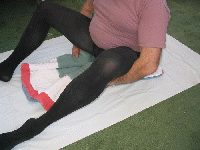
This will make for a comfortable pad to sit on. If you simply "scrunch up" the diapering to fit it between your legs, it won't be all that comfortable! At this point I prefer to apply talc, as all the dropped talc lands on diapering that will go against my skin where it can do some good.
Now I'll grasp the top of the pleated diaper in front and I'll lay down on my back as I pull that 8-inch wide pleated diaper up between my legs. Get it nice and snug! Think of the pleats now as leg bands, and get them as high into your crotch as possible.

Now to interweave the wings.
We refer to the diaper wings as the part that wraps around your sides and gets pinned. Separate the wings of the three diapers to make it easier to sort them out. Smooth the front wing of the innermost diaper over your thigh and bring the rear wing up and over it.
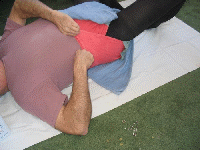
Start with the left side. Keep pressure on the innermost diaper wings while you smooth the middle-diaper wing over your side to cover the inner wings, keeping pressure on, so that the cloth does slip. Pull the rear wing of the middle wing up and over, transferring fingers to hold the pressure. Concentrate on just getting the leg band snug at this time. Then bring the outer-diaper front wing over the other two, and bring the rear wing forward, transferring finger pressure to hold the snugness you are achieving, and finally bring the rear wing of the outer diaper over all the others and maintain the pressure with one hand while reaching for a pin with the other. Pin the wings as low on your thigh as possible, right at the very edge of the diaper.
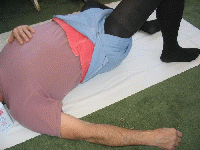
Before we move to the right side, let's divert a moment to talk pins and pinning: I one time could advise you to pick up a couple of packages of diaper pins in the supermarket in the baby diaper section ... but that seems to be a thing of the past now. You may have to venture to drug super-mart or a retailer like a Sears or Walmart and go to the infants' department to find diaper pins. Look for "made in USA" if you can find it; quality generally is somewhat better. Otherwise, get several packages of four and expect some of the pins to be rejects which you will just toss out.
If you are going to wear multiple diapers as I suggest and adequate diapering as recommended, which means 24 to 30 ounces of diapering, you will be happier with a bit larger pin. Angel Fluff Diaper Co. offers a diaper pin one size larger than baby diaper pins. These all-metal pins work very well for me! Do not be tempted to try still larger pins, more properly called "blanket pins" and found in fabric/sewing shops and tack shops (where they sell equestrian supplies for the horseback riders, owners, enthusiasts). While they may seem a great idea, the larger-size pin involves a larger diameter, and it becomes difficult or impossible to force the big pin through a dense material such as cotton diapering. It only goes through loosely woven material such as woven blankets with normal effort.
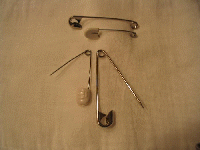
The looser woven fabrics such as gauze (rare) and terry cloth will pin the easiest. Birds-eye will be a bit tougher, and flannel will be about the toughest diaper to get a pin through. However a sharp pin shouldn't be a major hassle. When a pin doesn't glide right thru, rock it side-to-side which will rotate the pointed end as you are trying to penetrate the cotton fabric. Do not, or dare I say, never! use excessive force. You will be asking for a serious sticking incident, complete with blood!
There is no need to attempt to pin through all the wings! Pinning to catch just the outer diaper is fine. If you are pinning on a light diaper, it is easy to get the pin all the way through and as you push the pin in slowly and gently you will feel the pin touch your skin. Back off a bit and turn the pin upwards to emerge and fasten. Your off hand is in more danger of getting stuck than your thigh! Pinning is more art than science, and it's very difficult to give you an ABC series of steps to follow. Just go easy, and you will pick it up with minimal or no blood! Pinning, especially four-pinning, is the snuggest, most secure method to secure a cloth diaper and keep it "up" to promote long term comfortable wear.
Back to diaper pinning!
Now move to the top of the diaper on the (left) side you just pinned the lower edge with the first pin. Resnug the wings at the top, holding in the stomach while you gently pull each wing in turn from the inner back out to the outer diaper. Again, keep pressure with one hand while reaching for pin #2 with the other, and pin the wings above; but not necessarily at the top of the diaper! Find the hollow / depression above your hip bone. Pin the diaper at that spot. That could mean the pin will be an inch or two down from the waist of the diaper. That's fine, we want the waist pressure right above the hips to resist sagging down.
Move to the other (right-hand) side and repeat, interweaving the wings of the inner, middle and outer diapers, concentrating the pressure at the thigh. Pin with the third pin.
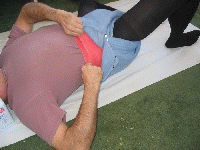
Finally, while sucking in the stomach, re-snug the wings at the top (waist), and find the hollow above the hip bone and pin with the fourth pin. This illustration shows the lower pin as low as possible on the thigh and the upper pin NOT at the very top of the diaper but in the hollow above the hip bone.
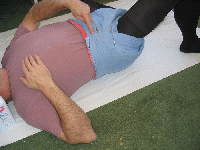
The idea here is to maintain the snugness by never letting go of the pressure on the diaper wings as you add one wing on top of the other. Note I am describing a weaving or overlapping on wings. It's like putting on three diapers individually; first the inner, then the middle and then the outer, but not pinning until you've put the outer diaper on.
I want to stress a "no bikini" look as you wrap the wings over your thigh to form a leg band. First pin goes as low on your thigh as you can get it.
Leg Bands
The idea of creating leg bands by pinning as low as possible on the thigh does a couple of things. First, it helps avoid chafing by marrying the diaper material to your leg so that it moves with your leg as you walk. Imagine if you simply two-pinned at the waist: you've got this diapering slung between your legs and it just hangs there as you walk, and your inner thighs rub back and forth on this cloth as you walk. Ouch! Abrasion and chafing!
The "leg band" technique helps to hold the diaper up! Our thighs have a bit of a "waist" of their own. That is, our thighs are a bit narrower at the top, right in the crotch area. So if we really snug the diaper in the crotch and low-pin to create a band around the thigh, the leg band will resist sliding down your leg and help with overall snugness and long-term comfort. Here we are pointing out the definite leg band or cuff we achieved with the pleating and the low pinning at the thigh.
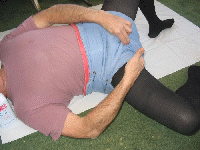
Finally, the leg band is handy for tucking the waterproofs under to improve leak-free security.
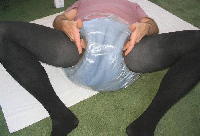
Incidentally, all this attention to snug-wrapping, interweaving and proper pinning is primarily aimed at those of us who will wear cloth diapers during the day when we are dressed in street clothes out-and-about. But, lest you think it's a complete waste of time for those wearing cloth diapers only at night, consider the amount of moving around before you get into bed and again the moving around after waking up in the morning ... make the coffee, put the dog (cat) out, pick up the newspaper. If you short-cut the snug-pinning technique, you could find that night diaper sliding down within a few steps of getting out of bed. With practice, the procedure is not time-consuming and is worth the time spent to keep your cloth diaper snug-and-up.
Toileting
I think it safe to assume that one who goes through this procedure just described to four-pin a cloth diaper is one who plans to wear that diaper until the time comes to change it. If one were planning to use the toilet at all, then some other diapering technique would be much more appropriate.
But what about the unexpected bowel movement for those who suffer only urinary incontinence? We all have differing dietary regimens and therefore different bowel habits that may well affect how we will wear cloth diapers during the day. If your bowel routine coincides with a diaper change, that would be ideal. But back to the situation where you find you need to relieve yourself at another time; how do you manage a visit to the toilet?
Our best advice for away-from-home and using a rest room stall is the following. If you are wearing suspender briefs, you will need to remove your shirt and hang it up (hopefully there is a hook). Slip the suspenders off your shoulders, lower your outer pants minimally, slip the suspender-briefs completely off the diapers and pull the plastic pants waist-band down just an inch or so, sufficient to expose the top pins. Unpin them and stick the pins into your shirt hanging on the hook. This keeps the pins handy and away from the possibility of falling into the toilet. Now slide the diapers and plastic pants down minimally, just enough to let you sit on the toilet and pass the bowel movement.
Inevitably, there will be some urine flow in the process. This flow is absorbed by the diaper since the diaper is lowered only partially.
Re-fitting the diapers back to their former position may offer a bit of a struggle. Pushing the leg bands up is a good start, then pull up on the waist. Repeat pushing the leg bands up and pulling up on the waist. This may take several repetitions. It helps if you can drop the pants all the way to your ankles to allow you to spread your knees while you push the diaper back up into the crotch. While this will "contaminate" your outer pants on the rest room floor, you can be careful to keep the suspender briefs totally within your outer pants to keep them off the restroom floor.
Once the diaper is back as high as you can get it, start on one side to resnug the wings and top-pin. Repeat on the other side, pulling each diaper wing in turn and keeping the pressure on, just as you did when first putting on the diaper. Pinning now can be more difficult depending on how wet the cloth is. Ideally the cloth on your sides will not be wet; that area of the diaper is next to last to get wet. If dry, the pinning pressure will be minimal, the same as when you first pinned the diaper on. If damp (or wet) then pinning will be more difficult since wet cloth resists the pin. Rotating the pin back and forth will help and more pressure will be needed which means much greater care is needed to avoid a pin stick.
This unhappy case of having to unpin to use the toilet points out one more advantage to the leg band concept. The leg bands you formed by low pinning will hold the diaper up when you remove the top pins. Yes, sliding the diapers down and then back up will be difficult, but possible. The diaper leg bands will maintain the integrity of the diaper and let you get back to a (somewhat) snug diaper following an unplanned partial removal.
Some have tried unpinning one side, lower and upper pins, and you may wish to experiment with that technique. It certainly is not something we want to do every day, but anyone who pins on cloth diapers has to face that time when it will be necessary to use the toilet and needs some plan to unpin and repin.
If you suspect that you may have an irregular bowel day, it would be wise to skip the pin-on cloth diapers and switch to disposables which are easy to slide down when using the toilet.
Summary
This chapter offers a technique of pinning cloth diapers that provides maximum leak-free security for several hours. That technique involves using four pins, interweaving two or three layers of diapers to create a snug fit around the torso. Through pleating the diaper, you create a comfortable seat with a thicker mass of cloth in the crotch that spreads out to cover the upper sides of the torso. In the process, leg bands are created that improve a snug fit. While all pinning involves "art" and attention to the contours of your own body, this technique allows you to adapt to your specific needs.
©2005 Incontinence Support Center